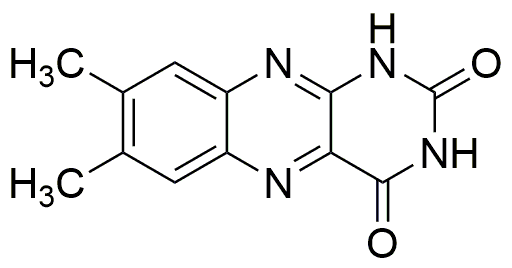7,8-Dimethylalloxazine is widely utilized in research focused on:
- Photovoltaic Applications: This compound is used in the development of organic solar cells, enhancing light absorption and improving energy conversion efficiency.
- Fluorescent Probes: It serves as a fluorescent probe in biochemical assays, allowing researchers to track cellular processes with high sensitivity.
- Analytical Chemistry: The compound is employed in chromatography for the separation and identification of various substances, providing accurate analytical results.
- Biochemical Research: It plays a role in studying enzyme activities and interactions, aiding in the understanding of metabolic pathways.
- Materials Science: Used in the synthesis of advanced materials, it contributes to the development of coatings and polymers with enhanced properties.
General Information
Properties
Safety and Regulations
Applications
7,8-Dimethylalloxazine is widely utilized in research focused on:
- Photovoltaic Applications: This compound is used in the development of organic solar cells, enhancing light absorption and improving energy conversion efficiency.
- Fluorescent Probes: It serves as a fluorescent probe in biochemical assays, allowing researchers to track cellular processes with high sensitivity.
- Analytical Chemistry: The compound is employed in chromatography for the separation and identification of various substances, providing accurate analytical results.
- Biochemical Research: It plays a role in studying enzyme activities and interactions, aiding in the understanding of metabolic pathways.
- Materials Science: Used in the synthesis of advanced materials, it contributes to the development of coatings and polymers with enhanced properties.
Documents
Safety Data Sheets (SDS)
The SDS provides comprehensive safety information on handling, storage, and disposal of the product.
Product Specification (PS)
The PS provides a comprehensive breakdown of the product’s properties, including chemical composition, physical state, purity, and storage requirements. It also details acceptable quality ranges and the product's intended applications.
Certificates of Analysis (COA)
Search for Certificates of Analysis (COA) by entering the products Lot Number. Lot and Batch Numbers can be found on a product’s label following the words ‘Lot’ or ‘Batch’.
Numéro de catalogue
Numéro de lot/série
Certificates Of Origin (COO)
This COO confirms the country where the product was manufactured, and also details the materials and components used in it and whether it is derived from natural, synthetic, or other specific sources. This certificate may be required for customs, trade, and regulatory compliance.
Numéro de catalogue
Numéro de lot/série
Safety Data Sheets (SDS)
The SDS provides comprehensive safety information on handling, storage, and disposal of the product.
DownloadProduct Specification (PS)
The PS provides a comprehensive breakdown of the product’s properties, including chemical composition, physical state, purity, and storage requirements. It also details acceptable quality ranges and the product's intended applications.
DownloadCertificates of Analysis (COA)
Search for Certificates of Analysis (COA) by entering the products Lot Number. Lot and Batch Numbers can be found on a product’s label following the words ‘Lot’ or ‘Batch’.
Numéro de catalogue
Numéro de lot/série
Certificates Of Origin (COO)
This COO confirms the country where the product was manufactured, and also details the materials and components used in it and whether it is derived from natural, synthetic, or other specific sources. This certificate may be required for customs, trade, and regulatory compliance.


